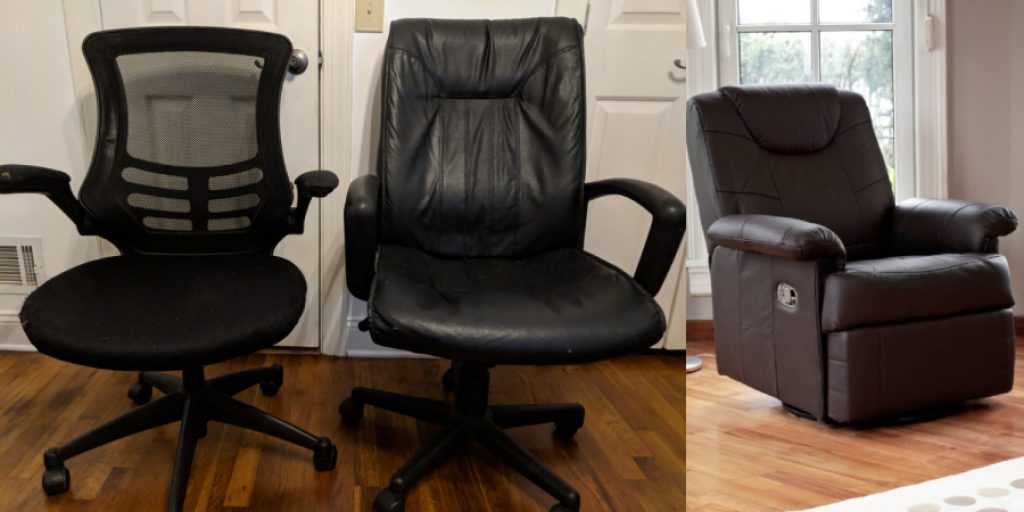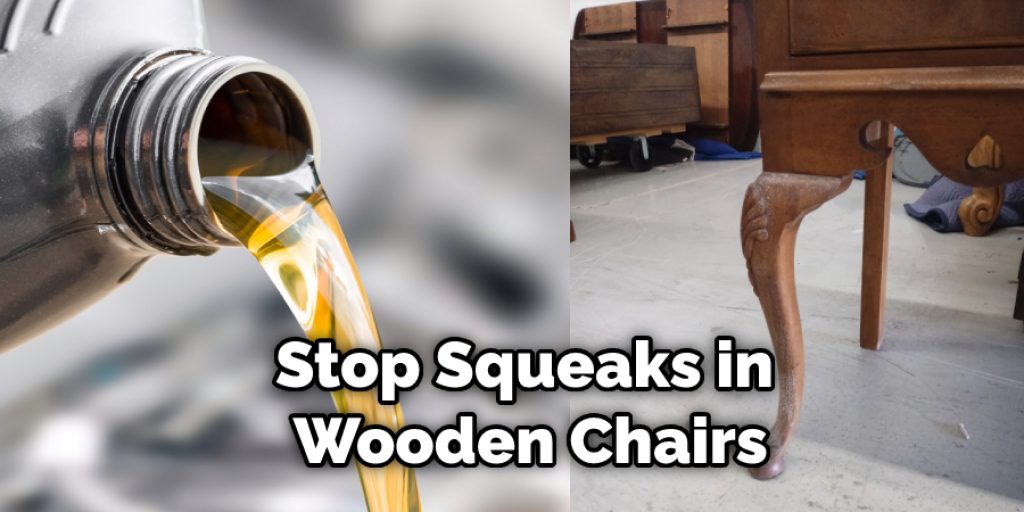How to Stop Leather Chair From Squeaking
If you’re like most people, you probably enjoy the comfort and style that leather chairs provide. However, if you’ve ever had one of these chairs, you know that they can often start to squeak after a while. It’s incredibly frustrating when you’re trying to work in peace or get some sleep, and the constant noise prevents that.

In this post, we’ll show you how to stop leather chair from squeaking so that you can continue to enjoy their comfort and style for years to come. Chairs can be a great source of comfort and support, but they can be incredibly annoying when they start squeaking. Whether the noise is coming from the seat or the arms of the chair, these tips should help you fix the issue. Read on for more information!
What is Causing the Squeaking?
Before we dive into the solutions, it’s important to understand what is causing the squeaking in the first place. There are a few common reasons why leather chairs start to squeak:
Loose Screws:
As with any piece of furniture, over time, the screws that hold your chair together can become loose. This can cause parts of the chair to rub against each other, resulting in squeaking noises.
Dry Leather:
If your leather chair is not properly conditioned and maintained, it can start to dry out. Dry leather can become stiff and creaky, causing squeaking sounds when pressure is applied.
Friction:
Another common cause of squeaking is friction between different parts of the chair. This can be due to a lack of lubrication or simply because the leather has started to wear down in certain areas.
Now that you know what could be causing the noise, let’s look at some solutions to stop your leather chair from squeaking.
Why Lubrication is Key
One of the most effective ways to stop your leather chair from squeaking is by using a lubricant. This can help reduce friction between different parts of the chair and prevent dry leather from rubbing together.
When choosing a lubricant, it’s important to use one that won’t damage or stain the leather. A silicone-based lubricant or even some household products like WD-40 can be effective options. Just be sure to test a small, inconspicuous area first to ensure it won’t cause any damage.
It’s also important to regularly maintain and condition your leather chair. This can help prevent the leather from drying out and becoming stiff, which can contribute to squeaking.
Needed Materials:
Before we dive into the steps on how to stop leather chairs from squeaking, let’s make sure you have all the necessary materials:
Lubricant (Silicone-based or Wd-40):
As mentioned before, using a lubricant can be an effective way to stop your chair from squeaking. Make sure you have one of these on hand before starting.
Soft Cloth:
You’ll need a soft cloth to apply the lubricant onto the chair.
Screwdriver:
If loose screws are causing the squeaking, you’ll need a screwdriver to tighten them.
Leather Conditioner:
Using a leather conditioner can help prevent dryness and stiffness in the leather, reducing the chances of squeaking.
12 Effective Ways How to Stop Leather Chair From Squeaking:
1. Rubbing Paraffin Wax on The Leather Recliner:
Waxing the leather of a chair is a way to help protect it. But if you also want to stop your recliner from squeaking, shell out some of that paraffin wax and rub it on the affected area. You can easily pick up a jar at any hardware or craft store. You may have to rub it in and buff the area for a while, but eventually, the wax should work its way into any grooves or crack and stop any squeaking.
2. Petroleum Jelly on the Screws:
The squeaking sound may be coming from a chair because of metal screws and other fasteners rubbing against the leather as it moves. To stop this, petroleum jelly is applied over those parts. Petroleum jelly is much better than oil-based lubricants that tend to seep into the leather and damage it.
3. Lubricating Metal Seats:
If the squeaking comes from metal chairs, you can use WD-40 or any other spray lubricant to stop them from making that awful sound. Consider utilizing a clean rag and taking out all dirt and dust before applying oil to any metal parts. If the chair is wooden, you can drill a hole in it and then add lubricant to the space.
4. Placing a Rubber Wristband on Chair Arms:
If you want to stop your chair from squeaking, try placing a rubber wristband over the arms and underneath the seat. This method is rapid and easy; just wrap one around each arm and gently pull it toward the back of the chair until it fits nicely and snugly. This is also a good trick if you want to prevent your chairs from scratching the floor.
5. Baby Powder Or Talcum Powder:
It is a well-known trick to stop squeaky chairs by sprinkling baby powder or talcum powder on the seat and arms. After that, you need to wait until it dries and remove all excess with a hand brush before using it again. This method can also be used for other non-leather furniture items. However, it is important to note that this treatment shouldn’t be used on leather seats.
6. Mineral Oil For Wooden Chair Legs:
It is often possible to stop squeaks in wooden chairs by lubricating the legs with mineral oil applied to a cloth or even directly onto the surface of the wood (if it’s untreated, obviously). Another great thing about this trick is that it can be used on other wooden furniture items to stop them from making any sounds.

7. Rubber Pads For Rattling Parts:
Rubber pads are a great way to fix rattling parts of the chair without dealing with unsightly-looking oils or waxes. Besides squeaks, the pads can also be used to prevent wobbly chair legs from making any sounds and stop other objects from rattling and making noise during transport. You can purchase these pads at any home improvement store.
8. Double-sided Tape:
Another thing you may try is double-sided scotch tape. Just stick it on the metal part of the chair arms, legs, or any other parts that may be the squeak source and then press it onto the leather. This tape can also be used to solve a wooden chair wobbling problem and stop rattling objects from making noise during transport.
9. Spraying Anti-Squeak Comp:
Another great way to stop squeaks is with an anti-squeak compound. This is an industrial-strength product that you can find at any major hardware store. You only need to spray it on the problem areas, allow it to dry, and then wipe it off. It’s also excellent for metal-on-metal contact, such as the springs in older chairs that tend to squeak when they rut’s
10. Oil on a Rag for Metal Parts:
A straightforward trick is to use oil from your leather care kit or even the mineral oil you have at home and apply it with a rag onto any squeaky metal parts of the chair. It will stop the squeaking immediately, but be prepared to reapply the oil regularly. Another great benefit of using this method is that it will also help prevent rust from forming.
11. Placing Bottle Beads in Chair Cushion:
Bottle beads are an excellent way to prevent that squeaking sound when someone sits down on your chair by adding them to the cushion. Just make sure you remove all of them before vacuuming because they may cause damage to the unit when sucked up. You can also try using the well-known trick of placing a couple of tennis balls inside the cushion.
12. Putting Pressure on Chair Parts:
It may sound a little bit strange, but this trick is one of the most effective methods to stop any squeaking in furniture. All you need to do is firmly press down all chair parts with your hand and then release. The continuous pressure will push the leather into the frame while making sure it doesn’t move.

Some Tips and Suggestions:
Here are some tips and suggestions on how to stop leather chairs from squeaking.
1. Squeaky leather chairs are caused by the friction of two surfaces that rub against each other. The following methods can help eliminate or reduce noise by freeing the leather’s surface of tension and friction.
2. Apply talcum powder, graphite, or silicone to any visible areas of squeak. These lubricants should be applied sparingly. They are not temporary solutions.
3. Crack the joints in your leather chair or sofa by repeatedly bending them up and down, then lubricating the surfaces that rub together. Test for squeaks after you bend each joint to tell where the noise is coming from. After identifying the location, distribute graphite or talcum powder to the area.
4. Apply rubber cement to loose or torn leather areas to reattach them. Rubber cement is available in the craft section in most major retail stores. But, again, dab it sparingly, don’t spread any on visible surfaces and allow it to dry completely before using your chair again.
5. If there are metal tubes in your chair’s joints, coat them with graphite or talcum powder.
6. If the squeaks seem to be coming from a metal part of your chair, apply oil or petroleum jelly and test for squeak after using it.
7. Apply white vinegar to leather surfaces that rub against each other and test for a squeak. Leather is made of natural products and sometimes reacts to acid, so you should test it for a reaction before using vinegar on your entire chair.
What Causes the Squeak in Leather Chairs?
The rubbing of the leather on the chair frame causes the squeaking. The leather has nothing to grip onto to keep it in place. This also happens because the person’s weight in the chair causes the leather to lean or stretch, and it slips back into place. It may also be caused by different temperatures, meaning when the leather is colder or warmer, and it moves in a way that causes squeaking.
What Will Fix the Squeak in Leather Chair?
There are several steps that you need to take before attempting any fixes. First, you should remove dust from underneath your chair with a vacuum and try not to sit on it as much as possible. Make sure all of the screws and bolts underneath your chair are tightened. If you do not know how to tighten these, seek help from a professional.

In most cases, it is simply because the leather has lost its flexibility and is causing friction against the metal beneath it. The dust and other particles that you vacuum out will decrease the friction and stop the squeak. You can also try spraying silicone lubricant between two surfaces. This will keep the leather from rubbing and should fix the squeak.
How To Stop Leather Recliner From Squeaking?
If you’re looking for a way to stop your leather chair from squeaking, look no further. It may be something as simple as tightening screws, or the problem may be more complicated than that. Here are some common causes and solutions to such issues that you can apply to get rid of the squeak. Of course, when trying to fix your squeaky leather chair, the first thing you need to check is that all parts are tightened and locked into place properly.
Look inside the armrests and back area for loose objects, such as coins or paper clips, that might have fallen in between the cracks of the chairs. If you find a loose screw, tighten it down a bit with a Phillips head screwdriver or a pair of pliers to make sure that the metal rod will not be able to move around and cause squeaking. You can also replace these screws if they are damaged in any way.
Frequently Asked Questions:
Q: Is It Safe to Use a Lubricant on My Leather Chair?
A: Yes, as long as you use a suitable lubricant such as talcum powder or silicone. It is essential to test it on a small, inconspicuous area first and use it sparingly. You should also avoid using oil-based lubricants as they can damage the leather over time. This is especially important if you have a high-quality leather chair.
Q: Can I Apply These Methods to Any Type of Leather Chair?
A: Yes, these methods can be applied to any type of leather chair, whether it is real leather or faux leather. However, it is essential to test any products on a small area first to ensure that they do not cause damage to the leather. It is also important to follow the manufacturer’s recommendations for cleaning and maintenance of your specific type of leather.
Q: Why Does My Leather Chair Squeak More in the Winter?
A: Leather is a natural material that can expand and contract with temperature changes. In the winter, when the air is drier, leather can become stiffer and more likely to squeak. Applying a lubricant or tightening screws can help alleviate this issue in colder months. You can also consider using a leather conditioner to keep the leather soft and supple all year round.
Q: How Can I Prevent My Leather Chair from Squeaking in the Future?
A: Regular maintenance and cleaning of your leather chair can help prevent squeaking in the future. Make sure to vacuum out any dust or debris from underneath the chair regularly and check for loose screws or other objects that may cause friction. Additionally, applying a leather conditioner every few months can keep the leather moisturized and less likely to squeak.
Q: Can I Fix a Torn or Loose Leather Area on My Chair?
A: Yes, you can use rubber cement to reattach torn or loose leather areas. However, it is essential to apply it sparingly and allow it to dry completely before using the chair again. If you are not confident in your DIY skills, it is best to seek professional help to repair your leather chair.
Moreover, avoid sitting on the chair with heavy or sharp objects in your pockets, and try not to lean or stretch too much on the chair. This will minimize the stress on the leather and reduce the chances of squeaking. Finally, if you notice any unusual sounds coming from your leather chair, address them immediately before they worsen and become more difficult to fix.
Conclusion:
Squeaky leather furniture is a common problem. There are several ways how to stop leather chair from squeaking. First, directly apply silicone spray or shoe polish (or both) onto the area that squeaks; let it dry for 5-10 minutes before using. Next, apply talcum powder on top of the cloth, brush into the surface where friction occurs with a side of hand until completely covered in powder; wait ten minutes before sitting down.
Use dental floss as an alternative solution by inserting string under the seam from the opposite direction, so one end sticks out each side. Apply pressure at either end of the string while pulling up towards you, tightening stitching enough to silence the offending chair leg. We hope this blog post has been helpful. If you have any questions or want to know more, then feel free to comment below!
You Can Check It Out To Open Recliner Without Handle
You may also read How to Keep Leather Car Seats Cool



